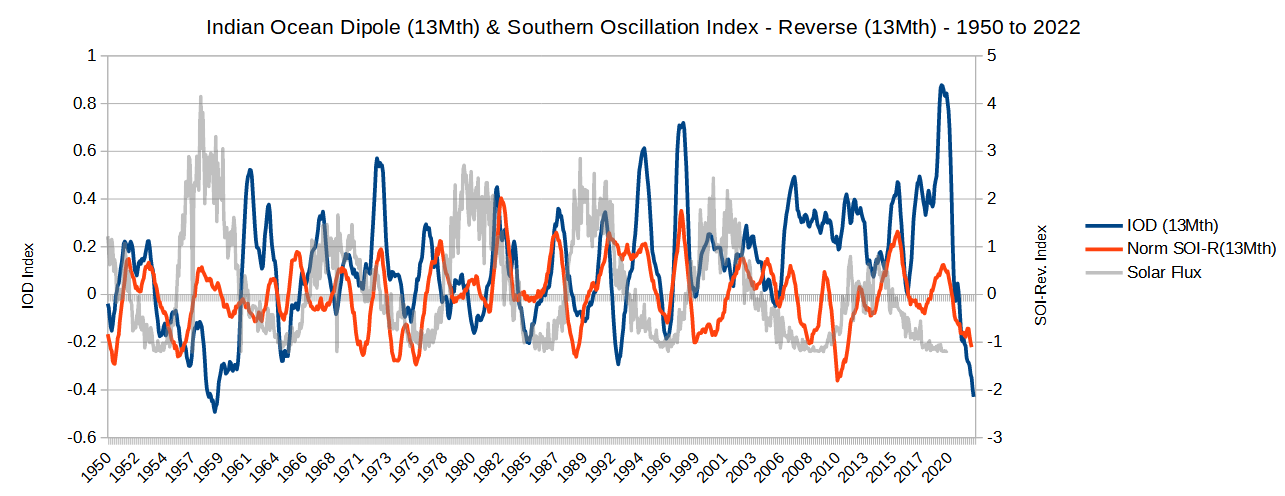|
|
Post by missouriboy on Aug 27, 2022 23:17:38 GMT
They say that Southwest Asia lives and dies by the Monsoon. Some years it's too much. Some years it's too little. This year it's too much in Pakistan ... and just right in India. Everyone is watching the headines for 2022 and screaming "worst ever". But 2010, also a La Nina year, was worse.
|
|
|
|
Post by missouriboy on Sept 5, 2022 0:32:11 GMT
The Indian Ocean Dipole has fallen all the way back to 1950s levels in the last three years. Warm water has withdrawn back to Oz territory ... after two major flood years in China and now drought, coupled by a wild flood year in Pakistan. Are we observing another element of a quasi-sixty-year cycle?
 |
|
|
|
Post by Sigurdur on Sept 5, 2022 1:00:51 GMT
|
|
|
|
Post by missouriboy on Sept 5, 2022 4:24:24 GMT
They all measure slightly different things in slightly different ways. So their actual numbers are not as important as whether their breaking points and general positive and negative cycles generally match. Theoretically their methodologies have been internally consistent over time. Like the PDO, the IOD is generally a measure of which side of the basin the warm water is located on, while ENSO is a measure of surface water temperatures in different regions of the Pacific. If measured with the Southern Oscillation Index, it is a measure of pressure differences from the central to western Pacific.
The drought ages he specifies seem to fit nicely in the Sporer and Maunder Minimum time frames.
|
|
|
|
Post by missouriboy on Oct 10, 2022 22:13:21 GMT
The Southwest Monsoon — More Erratic?
|
|
|
|
Post by blustnmtn on Oct 10, 2022 23:16:01 GMT
The Southwest Monsoon — More Erratic?
The Media are the enemy of truth. |
|
|
|
Post by missouriboy on Jul 19, 2023 22:24:54 GMT
|
|
|
|
Post by missouriboy on Feb 27, 2024 15:15:14 GMT
Ratty! Have you you ever run across a listing of all the variables that go into the IOD index formula? If the IOD is truely a measure of warmer-water positioning, then somewhere there must be a dataset that contains quasi(?)-SST values across the width of the Indian Ocean? By longitude? Sure would be nice to have that (those) timeseries.
|
|
|
|
Post by ratty on Feb 27, 2024 21:10:17 GMT
Ratty! Have you you ever run across a listing of all the variables that go into the IOD index formula? If the IOD is truely a measure of warmer-water positioning, then somewhere there must be a dataset that contains quasi(?)-SST values across the width of the Indian Ocean? By longitude? Sure would be nice to have that (those) timeseries. Did a quick search .... nothing to report. You might spot something in this search? I'd ask my friends at the BoM but I'm fearful they might recognize my name and some of the things I have written about them.  |
|
|
|
Post by missouriboy on Feb 27, 2024 23:58:22 GMT
Ratty! Have you you ever run across a listing of all the variables that go into the IOD index formula? If the IOD is truely a measure of warmer-water positioning, then somewhere there must be a dataset that contains quasi(?)-SST values across the width of the Indian Ocean? By longitude? Sure would be nice to have that (those) timeseries. Did a quick search .... nothing to report. You might spot something in this search? I'd ask my friends at the BoM but I'm fearful they might recognize my name and some of the things I have written about them.  They specifically state that they use Indian Ocean west and east SSTs ... so, no doubt, they have these squirreled away somewhere.  |
|